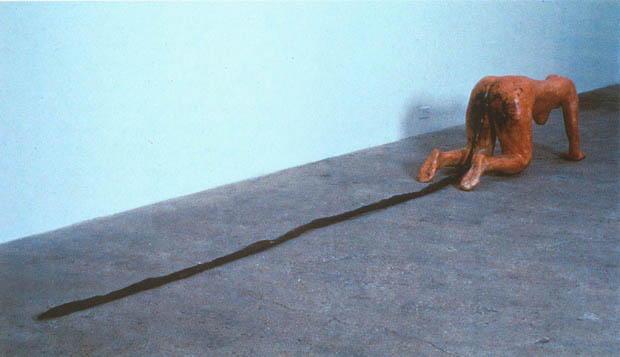
Artist: Kiki Smith
Work: Tale (1992)
lSize: 160” X 23” X 23” l
Type: Sculpture
Type: Sculpture
l
The Artist
Kiki Smith is an American artist and she is also regarded as a Feminist artist. She made sculptures of figures losing control of bodily processes, oozing blood or trailing feces behind them. She is famous for her use of female imagery and bold experimental sculptures.What is it?
This work is the most controversial work from SmithIn the work, a female sculpture which is in a prostrate gesture is shown. It is naked and is crouching on all fours while defecating a long, snakelike turd onto the floor. Moreover, There is full of dirt on her body, especially on her bottom. And What makes the work unusual is the excrement; this excrement was excreted from the back of the body and is trailing behind her. On the whole, the work presents a dirty woman which disgust audiences.
What are the messages?
* Things that human cannot hide from themselves
The work actually shows our embarrassment on something, for example, the process of excrement. The feces represents some sort of internal personal garbage that you are dragging all the time. And it also states the shame and humiliation of not being able to hide things that are so apparent in one's own being.
* Shame on hiding what we actually are
Our first impression towards this work may be negative. We may feel disgusting, ashamed and want to skip it. However, when we think in depth, we should feel grief since we tried to hide things that are normal (Physical, bodily processes). And I think that is the real shame when we tried to omit what oneself truly is and to omit one's true existence.
* Potential questioning the concept of "tradition"
When we look at this work, we may think about the "tradition" matter. What is the tradition way to show human body? ( especially woman body). Are they always perfect? graceful? Clean? Tidy? Smooth? Actually Smith's work are always regarded as something "different from tradition". In my opinion, Smith's work exactly point out the true side of "tradition". The work shows the imperfect side of human and that is the realistic part about all human since none of us is perfect.
* Make people rethink, evoke self-examination on physical body
Is one's body a burden of ones? It carries meaning or trap one's spirit? Smith's work reminds the audience that our body contains mortality. Everyone of us have to face birth, aging, illness and death; these are things that none of us can hide from.
My association towards the work
When I look at the work, I think of two extreme things, the elderly who suffer from incontinence and baby who always need their parents to bath them. It shows that human is sometimes unavoidably weak and all of us should embrace that in our lives.
Question
Do you think that the messages the art work presents will still be the same if the figure is changed from a woman to a man? Why or Why not?
I think the general meaning would be the same, for example, things that we cannot hide and the shame that we tried to avoid it in our lives. However, I think the female figure actually enrich the work since it emphasizes the contrast between the tradition woman body and the realistic woman body. I reckon that the artist tries to remind the audience of human weakness. And sometimes we have to face our true selves instead of hiding it.
Reference

No comments:
Post a Comment